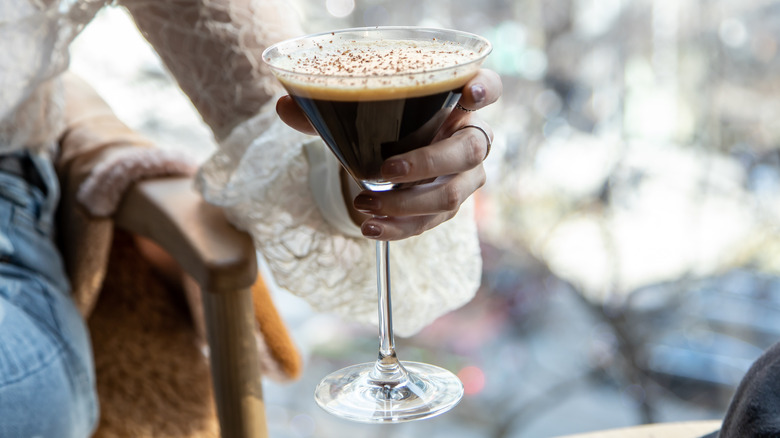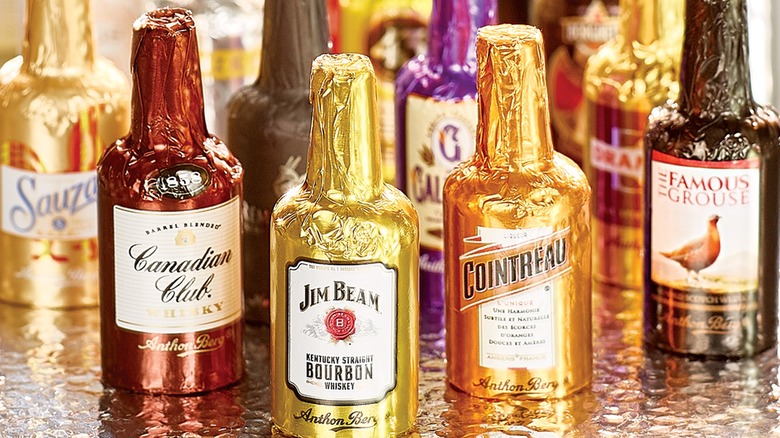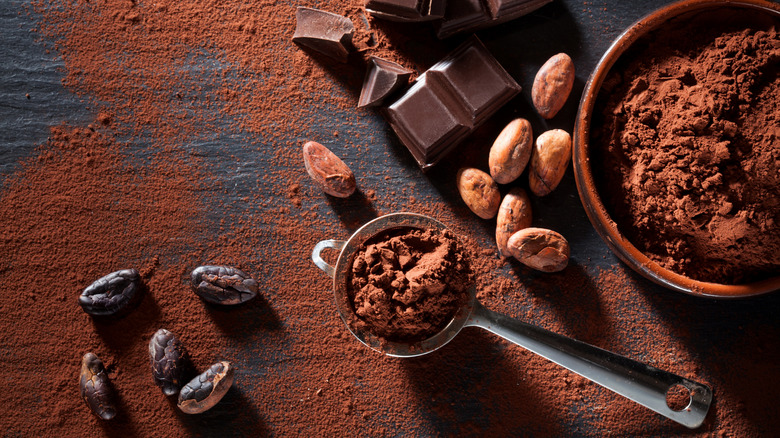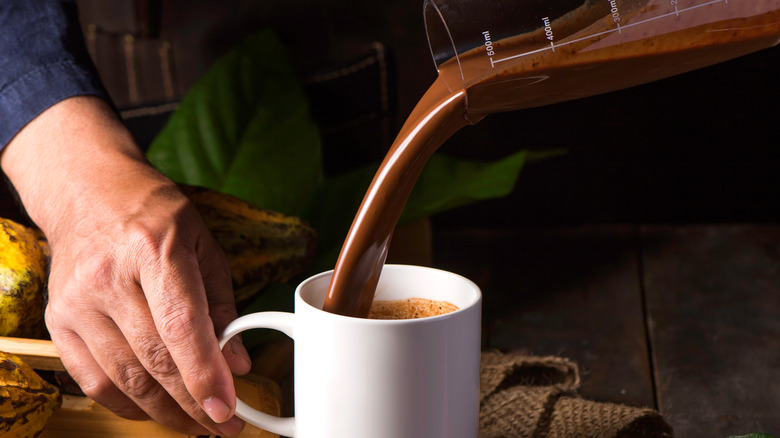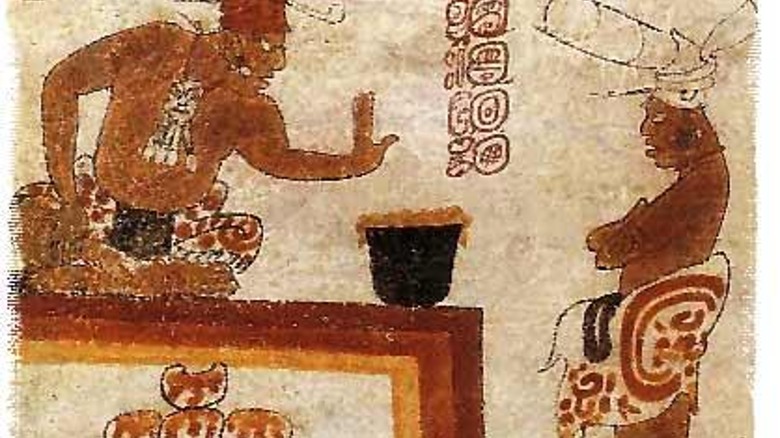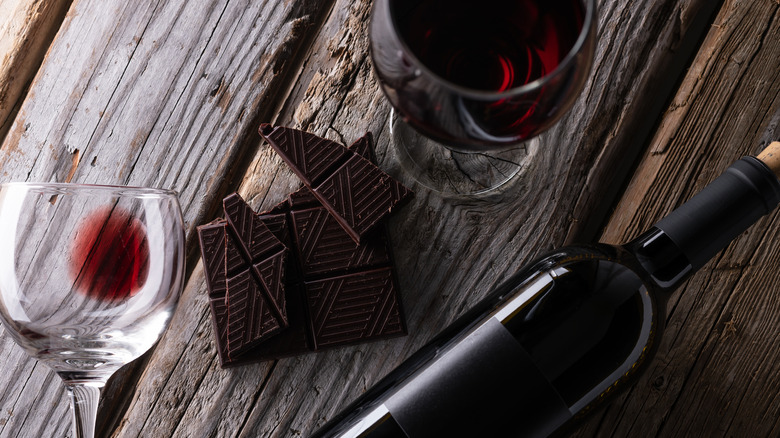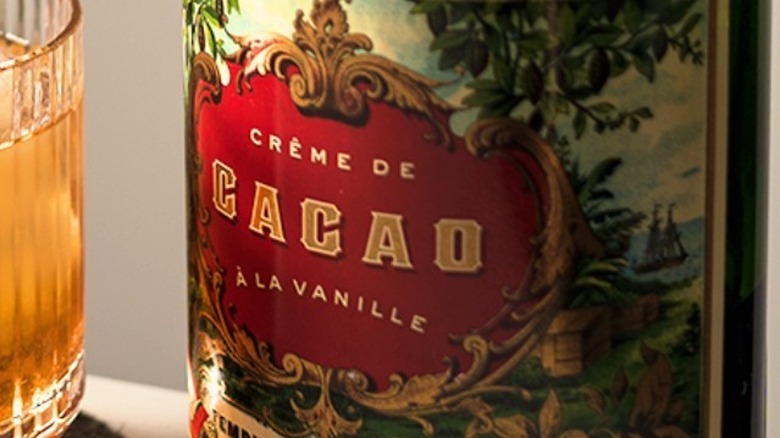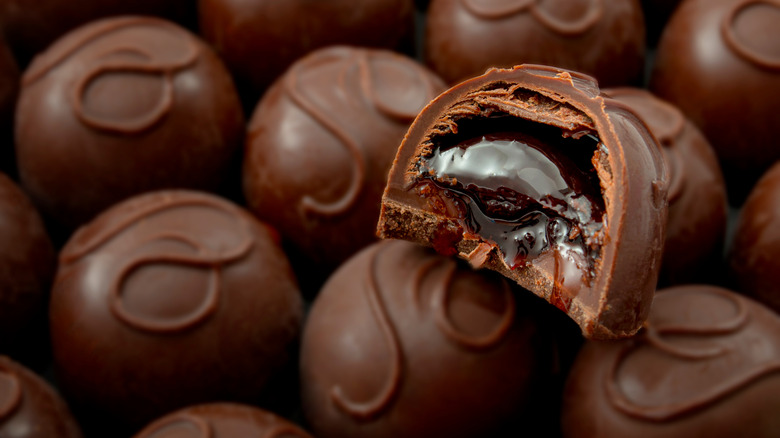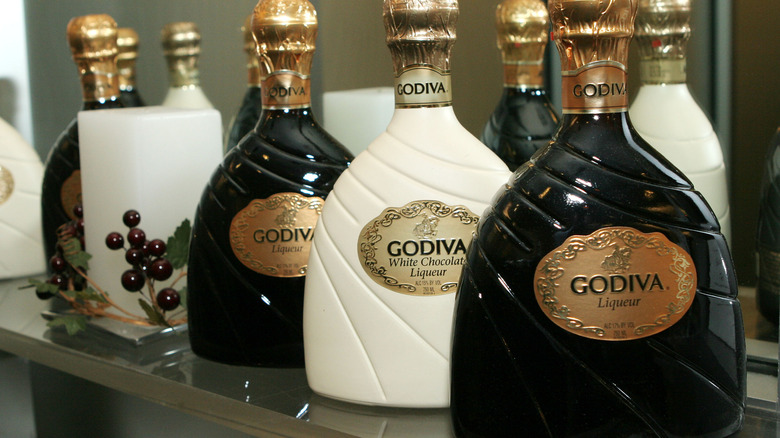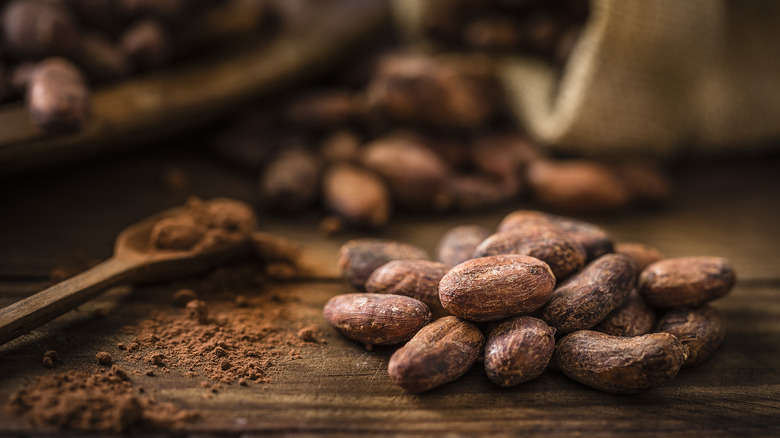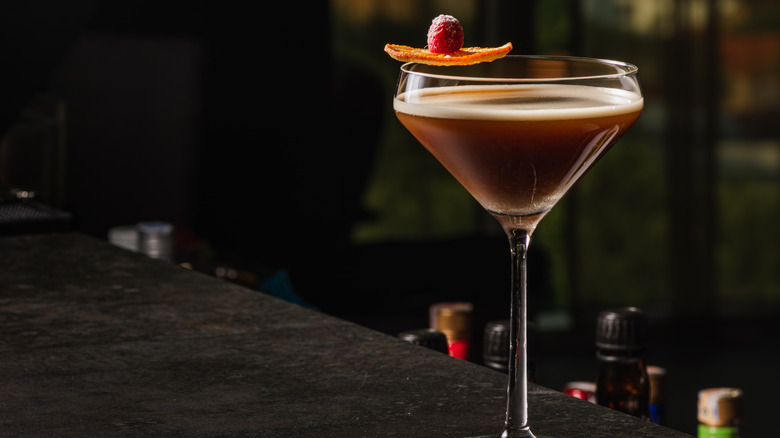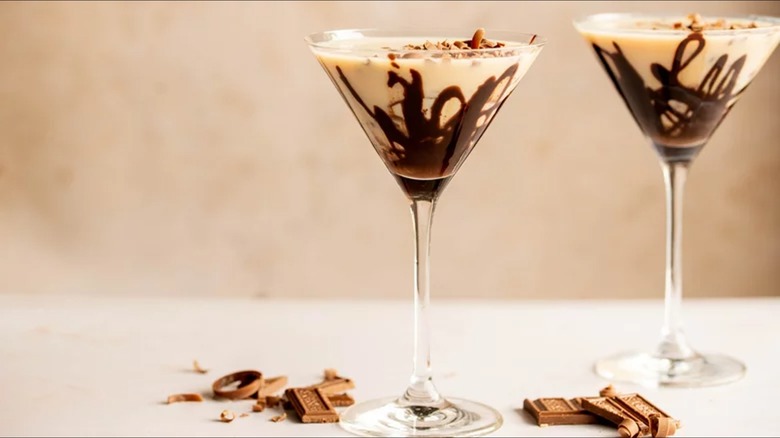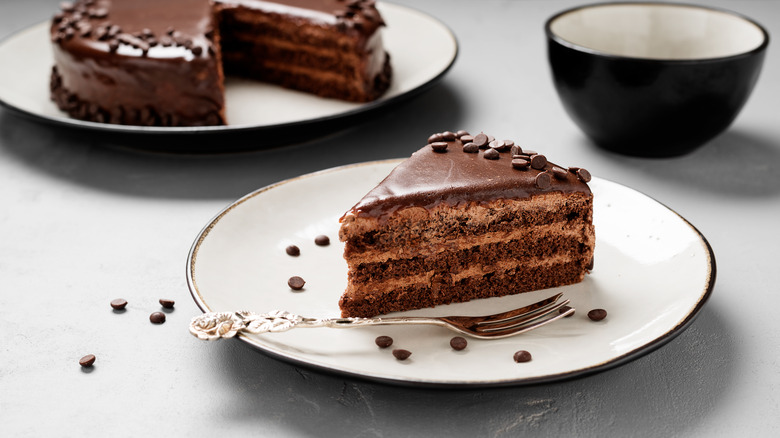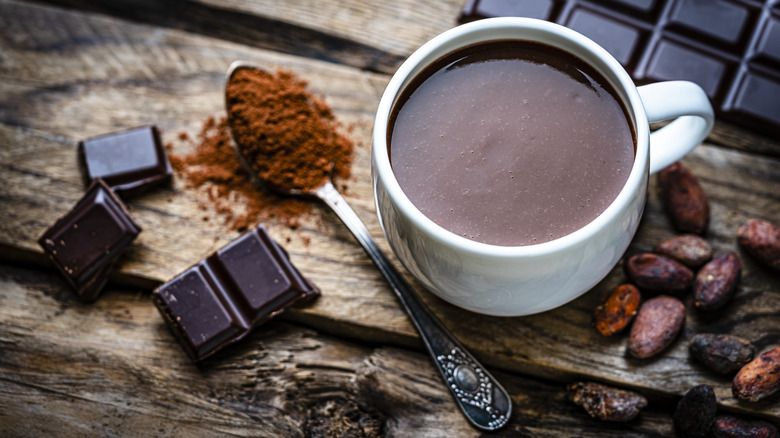What, Exactly, Is Chocolate Liqueur?
Chocolate liqueur merges liquor and chocolate into a beverage that is pure liquid indulgence. The balance between the smooth flavors of cocoa and the warmth of spirits creates a drink that is pure decadence. We're here to fill you in on this alcoholic drink since it's easily confused with another liquid. Plus, there are two types of chocolate liqueur. However, once you've delved more deeply into the topic, you'll not only know how to use the term properly, but you'll also have a better idea of the liquid version's place in your liquor cabinet.
The story of chocolate liqueur includes a rich history that originated with ancient Mesoamerican cultures and was reinvented by the Europeans. In modern times, the liquid version has become a beloved beverage that has a place in a variety of cocktails and even non-drinkable chocolate desserts. If you've been wondering exactly what chocolate liqueur is, how it came to be, and how to use it, we have plenty of information to share to help you become an armchair expert.
There are two types of chocolate liqueurs
When you hear people talk about chocolate liqueur, you'll want to make sure you understand which one they mean because there are two kinds. One is a beverage, and one is a candy. Unless stating otherwise, we will be talking about the beverage version.
If someone is talking about the drink, they're referring to a certain category of alcoholic beverage that contains chocolate. The use of chocolate liqueurs has been traced to ancient civilizations, long before chocolate made its way across the oceans to Europe to be turned into an alcoholic beverage yet again.
However, if someone is talking about the candy version of chocolate liqueur, they mean chocolate candy that contains a pocket of alcohol. These treats got their start in 1920s Germany. The story goes that brandy producer Hugo Asbach created the candies for ladies who wanted to imbibe in alcohol but were discouraged from drinking publicly because of social expectations. These solid chocolate liqueurs featured chocolate on the outside and a delicious brandy filling. These days, the candies contain a wide variety of alcohol types to match specific flavor notes.
It starts with chocolate, and it's alcoholic
There aren't hard and fast standards for chocolate liqueurs except for this: They contain both chocolate and alcohol. So, if you were wondering whether chocolate liqueurs contain alcohol, the answer is yes. This definition goes for both the candy version and the beverage version.
The beverage version combines a base distilled liquor like vodka or whiskey with milk chocolate or dark chocolate. These beverages are also sweet. Some contain creamy ingredients to make them more like rich chocolate milk, while others are just chocolate and alcohol to allow you to use them more freely. A few brands contain extra flavorings to make them unique, so it's a good idea to read the label to find out if you're getting one infused with an ingredient that might clash with the cocktail you want to create.
Meanwhile, the candy version has either an alcoholic liquid filling encased in chocolate or alcohol cooked in with the chocolate. The filled ones use a process called starch casting that involves first making an alcohol-filled starchy sugar shell that keeps the liquor from evaporating through the chocolate.
There's a difference between liquor, chocolate liquor, and chocolate liqueur
If you're wondering why we're using the phrase "chocolate liqueur" instead of "chocolate liquor," it's not because we're trying to be fancy. There are actually differences between liquor, chocolate liquor, and chocolate liqueur, so the terms aren't interchangeable. Interestingly, only two contain alcohol.
First of all, there's a difference between liquor and liqueur. When we talk about liquor, we're referring to all fermented and distilled alcoholic beverages. There are both unsweetened and sweetened versions. However, when we talk about liqueurs, they are always sweetened liquors. So, all liqueurs are liquor, but not all liquors are liqueurs. Either one can have extra flavors (unless it's strictly regulated like pure whiskey). However, something labeled as a chocolate liqueur is always going to taste sweet, always be alcoholic, and always contain chocolate.
Strangely enough, you should throw everything you know about the word "liquor" out the door when it comes to understanding the term "chocolate liquor." Chocolate liquor is a milled liquid of cocoa bean nibs that manufacturers use to make chocolaty treats like chocolate bars. The 18- to 72-hour milling process helps to release fat to make the dried bits of cocoa beans smooth. There is no alcohol in chocolate liquor. If you look at the etymology of the word "liquor," it was first used just to mean a liquid before being narrowed to refer to fermented and distilled beverages. So chocolate liquor has no alcohol, while chocolate liqueur does.
The earliest fermented chocolate beverages were from Mesoamerica
When European explorers found the New World, they also found civilizations that were consuming something completely new to them: chocolate. The history of non-alcoholic chocolate beverages goes back to the Mesoamerican Mayan culture and possibly back even further to the Olmecs of southern Mexico. The Mayans were also in southern Mexico, but their territory expanded throughout Central America from Guatemala and Belize, through El Salvador and Honduras, and all the way to Nicaragua.
While chocolate was popular as a drink throughout Mesoamerica and also consumed by the Aztecs of northern Mexico, the earliest evidence of an alcoholic chocolate beverage is from Honduras sometime between 1100 B.C. and 1400 B.C. The drink would have been somewhat sweet since people there used the sweet pulp surrounding cacao seeds to make it. However, there wasn't any evidence of honey or other flavorings like chili or vanilla in it like in later Mayan chocolate beverages. While it was only about 5% alcohol, it was still popular for feasts and gatherings.
[Image by Mayan civilisation via Wikimedia Commons | Cropped and scaled| CC-PD-Mark]
Fermented chocolate beverages first became popular in Europe in the 1600s
Despite there having been fermented chocolate drinks in Mesoamerica before Old World explorers first visited in the late 1400s, it was chocolate rather than fermented chocolate beverages that made its way to Europe in the mid-1500s. However, it wasn't long before Europeans were turning it into a sweetened drink. It took about a hundred years before we have records indicating that anyone in the Old World experimented with fermenting it.
Fermented chocolate beverages can be traced to the mid-1600s and have only become more popular through the centuries. Many early fermented chocolate beverages started with a base of sweet wine like port or sherry. The first published recipe we find for it came from a cookbook Hannah Woolley published in 1672. Her version contained a red wine called claret mixed with chocolate into a drink.
The history of true distilled chocolate liqueurs is rather murky. Crème de cacao may have been the first fermented and distilled chocolate beverage, possibly making it the first chocolate liqueur. Legend has it that Bénédictine monks in France may have been the first to create crème de cacao back when they were experimenting with a variety of liqueurs in the 1600s.
Crème de cacao is a subset of chocolate liqueur
The chocolate liqueur crème de cacao may confuse you since it isn't a creamy beverage. While the term "crème" often means "cream," when it refers to liquor, it can just mean that it's a sweetened alcoholic beverage -– essentially a liqueur. So, crème de cacao doesn't come from cream made from cacao, and it doesn't contain cream. However, it's a chocolate liqueur because it is sweet and is derived from cacao like chocolate is.
To create crème de cacao, some manufacturers distill cocoa beans or nibs into a sweet, clear, alcoholic, chocolate-flavored liqueur. When added to cocktails, it provides a nice chocolate flavor without turning the drink muddy and brown. However, other manufacturers macerate or percolate the cacao nibs or beans directly in the liquor, which results in a darker version.
Most other chocolate liqueurs are thicker ones blended directly with chocolate rather than essentially being distilled, steeped, or brewed with nibs or beans. These other types sometimes tend to have more of a creamy texture. So, if you're looking for a thick and creamy, chocolate-flavored liqueur, you can skip crème de cacao.
Chocolate liqueur's alcohol content varies in the candy version
If you ever tried getting a buzz from the chocolate candy version of chocolate liqueurs, you may have been disappointed. Most contain just a small amount of alcohol inside of a gel-like filling. Some even contain alcohol cooked into the chocolate itself. While a percentage of the alcohol may cook off, some will still remain. So, in most cases, you'd have to consume several bites to start getting tipsy.
A few people have experimented to see whether they could get drunk from eating chocolate-filled candy. Some said the nausea from all the sugar started kicking in before they felt very buzzed, but they powered through. Both 10 and 20 candies gave one experimenter a blood alcohol concentration (BAC) of 0.03% (a level of 0.08% is considered legally impaired while driving). Thirty chocolates brought it up to 0.05%, and 45 brought it up to 0.07%. Another felt buzzed after 20 candies, but their BAC was still at 0.00% because of the low amount of alcohol in each candy (or maybe it was a faulty breathalyzer). Not every variety as has much alcohol as others.
So, you can get a little tipsy from the candy version of chocolate liqueur, but your stomach may start rebelling against all the sugar before you manage to get drunk. It seems to take pure dedication to get a decent buzz from them.
There are several popular varieties of the drink
Every chocolate liqueur comes with a different spin, so you can't expect to get the same thing with each variety. You have to read the label. Different types use different kinds of sugar, are made differently, contain different types of alcohol, and have different texture and flavor profiles. We'll give you an example of the differences by highlighting a few brands.
Some are less creamy since they use chocolate to infuse the alcohol rather than to mix in with the alcohol. Organic Mixology (OM) Chocolate Liqueur macerates fair-trade chocolate in sugarcane alcohol, uses an agave sweetener, and is 17.5% alcohol. OM's Dark Chocolate & Sea Salt Liqueur tastes like caramel, salt, and chocolate and contains 17.5% alcohol. Blackfish Chocolate Liqueur is infused with fair-trade cacao nibs and comes in at 22% alcohol. Then there's Heritage Distilling Co. Cocoa Bomb Chocolate Whiskey that uses cane sugar, tastes like dark chocolate and marshmallows, and has 37.5% alcohol.
Thicker ones mix chocolate in with the alcohol for the finished product. Belgium's Godiva Chocolate Liqueur is a creamy version made with Godiva chocolate, contains 15% alcohol, and comes in a variety of flavors. Italy's Bicerin Originale di Giandujotto is thick and contains a chocolate hazelnut flavor and 15% alcohol. Poland's Dorda Double Chocolate needs shaking because it's so thick, and it contains 18% alcohol. Yet another is Pennsylvania Dutch Chocolate Cream, which is a creamy 12.5% alcohol liqueur with milk chocolate, vanilla, toffee, and hazelnut flavors.
It almost always contains caffeine
Since chocolate liqueurs use cacao or chocolate itself in the production process, they do contain caffeine. The only exception is when the chocolate liqueur uses white chocolate instead. While most cocktails won't contain a lot of liqueur, the caffeine content might still pep you up a bit. So, you might want to rethink drinking a cocktail with chocolate liqueur later in the day if you're worried that it might affect your sleep.
Unfortunately, most chocolate liqueur companies aren't in the habit of giving out information about caffeine content. So, if you're concerned about the amount of caffeine in your drink, you'll want to consider which type of chocolate it contains. According to the U.S. Department of Agriculture (USDA), an ounce of dark chocolate contains 12.2 milligrams of caffeine (in comparison, one ounce of black coffee has between 8.8 and 17.5 milligrams of caffeine). The federal agency also says that an ounce of milk chocolate candy contains about 5.7 milligrams of caffeine. Meanwhile, white chocolate contains absolutely no caffeine (per USDA). So, a dark chocolate liqueur will contain significantly more caffeine than a milk chocolate liqueur. Meanwhile, a white chocolate liqueur (like Godiva White Chocolate Liqueur) will contain none at all.
Several types of the drink are dairy-free
If you're lactose intolerant, allergic to dairy, or a vegan, the good news is that not every type of chocolate liqueur includes dairy products. Luckily, even some creamy versions are dairy-free these days.
The ones that you don't have to ever worry about containing dairy are the clear distilled types like crème de cacao and the ones that infuse the alcohol with cacao beans or nibs rather than mix in chocolate.
Unfortunately, it's when you get to the creamy versions that you're more likely to encounter dairy products and need to do a little research to find non-dairy alternatives. Marks & Spencer Chocolate and Coconut Cream Liqueur uses coconut cream and coconut oil to give its chocolate liqueur a creamy texture. Mozart Chocolate Coconut is also dairy-free since it uses cocoa butter and coconut oil instead of dairy to make it creamy. There are also lots of recipes for making your own dairy-free chocolate liqueur. While most recipes contain coconut products, a few use dairy-free cream like ones made from oats.
It's popular in a variety of cocktails
If you end up buying chocolate liqueur and want some ideas for it, there are plenty of cocktails you can make. They integrate various other liquors and often combine extra cream and maybe some extra chocolate and other ingredients to create a dessert drink.
Most chocolate liqueur cocktails come together with chocolate liqueur and another liquor or two. A Cadbury Egg martini requires vanilla vodka, for example. Vodka and Bailey's Irish cream combine with chocolate liqueur to make chocolate martinis or a frozen cocktail called a Bailey's frozen Russian cocktail. A chocolate sidecar is a cognac- and port-based cocktail with chocolate liqueur. Gin fans might enjoy a Ramos chocolate fizz or an Alexander. If you like brandy, you might want to try a brandy Alexander. Meanwhile, some versions of a bounty require amaretto. Try a bushwacker alcoholic milkshake if you like rum and coffee liqueur with your chocolate liqueur. If you like minty drinks, add in crème de menthe for a grasshopper cocktail or vodka and peppermint Schnapps for a chocolate peppermint martini. There's even a chocolate margarita for tequila lovers and chocolate puffs using golden rum.
Several bourbon drinks feature chocolate and chocolate liqueurs. These cocktails include brown butter old fashioneds and chocolate bourbon cocktails. Bourbon balls add in hazelnut liqueur with the bourbon and chocolate liqueur. Chocolate coffee bourbons require chocolate liqueur, coffee liqueur, and bourbon. Meanwhile, chocolate Sazaracs add absinthe to the bourbon and chocolate liqueur combo.
Chocolate liqueur is useful in many types of treats
If you're trying to figure out what to do with leftover chocolate liqueur, there are plenty of treats you can add it to. After all, the alcohol isn't just for drinking.
It's excellent in a variety of desserts ranging from chocolate lasagnas and chocolate souffles to chocolate yule logs and chocolate-filled crepes. You can add it as an ingredient to cakes and their frosting, and it even elevates a chocolate pecan pie. It works well in softer desserts like chocolate pudding or crème brûlée, too. Another fun way to use it is in chocolate fondue.
On a hot summer day, you might use it to make chocolate liqueur ice pops or add it to a chocolate milkshake. You can even make your own chocolate liqueurs (the candy version) with chocolate liqueur (the beverage version). Basically, if it's something you normally make with chocolate, you can substitute some of the regular liquid with chocolate liqueur.
You can make your own chocolate liqueur beverage at home
With a few ingredients, you can construct your own chocolate liqueur at home. That way, there are no surprises regarding the flavor profile and ingredients. You can add exactly the kind and amount of sweetener you want, use your favorite chocolate, add extra flavorings (like chili powder), and dictate whether it gets dairy products or not.
There are lots of recipes for making creamy chocolate liqueur. One method involves boiling together unsweetened cocoa powder, sugar, milk, and heavy cream to make a rich hot chocolate before adding vodka. Most recipes for non-dairy chocolate liqueur involve boiling together unsweetened cocoa powder, sugar, full-fat coconut milk (or another creamy coconut product), and adding vodka before storing it in the fridge.
There are also several ways to make a version without a creamy texture. One non-creamy version involves making sugar syrup and cocoa powder syrup, adding them together, straining the mixture, adding vodka, and refrigerating it for a week before using it. Another version involves steeping cacao nibs in a mixture of vodka, water, sugar, and vanilla. You'll steep it over a week and strain out the cacao nibs.
